Sally Stewart of Orange County, New York
1822
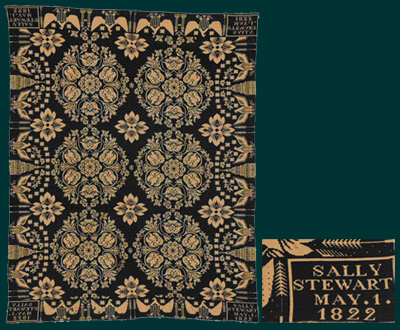 |
Sally Stewart’s coverlet is a good example of New York style. The earliest New York weavers were immigrants from the British Isles and had been trained in carpet weaving. Sally’s coverlet--made by a Scots-Irish immigrant--has large medallion designs similar to those found on British carpets of the period. But the eagle motif in the coverlet’s border is purely an American expression. ID.2007.72.45 Gift of the Fred and Margaret Brusher Family |
This coverlet was made for Sally Stewart. But who was she? The coverlet closely resembles those made by Scots-Irish immigrant weaver James Alexander of Orange County, New York. Alexander’s account book shows that a Mrs. Stewart ordered four coverlets in 1821, and that the names to be woven into the coverlets were Lydia Stewart, Jane Stewart, Sally Stewart and Nancy Stewart. Perhaps Mrs. Stewart was ordering coverlets for her four daughters--including the Sally Stewart who owned this coverlet.
This coverlet holds other clues. The top and bottom borders depict Masonic columns and the square and compass emblems. Did Stewart family members belong to this ritualistic fraternal organization, a “secret society” whose tenants included belief in a Supreme Being and moral standards?
It is likely that Sally lived in Orange County, New York, since that was the location of James Alexander’s weaving business. Orange County borders the Hudson River on the east and is about fifty miles north of New York City. Many of the people who lived in the area were of Scottish ancestry--including not only the weaver of this coverlet, but also likely its Stewart family owner.
Betsey Keator of Delaware County, New York
1829
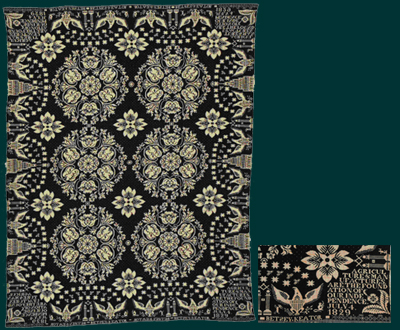 |
Betsey Keator’s coverlet expresses a patriotic fervor common in coverlets made in New York state. ID.2007.72.28 Gift of the Fred and Margaret Brusher Family |
Betsey Benjamin Keator was a young bride when she had this coverlet woven by an unidentified local weaver. Twenty-year-old Betsey had married George Keator the year before, in January 1828. George and Betsey lived their entire lives in Roxbury, Delaware County, New York.
An inscription woven into the coverlet reads, “Agriculture & Manufactures are the Foundation of Our Independence.” Found on a number of New York coverlets, this sentiment expresses the patriotic fervor of a young America--and a belief that farming and manufacturing would be at the heart of its economic success and political independence.
The designs on Betsey’s coverlet look very similar to those on Sally Stewart’s above. Both women lived in eastern New York, just two counties from each other. Customers like Betsey chose their coverlet pattern design from those the weaver had available. Coverlet pattern designs were often woven by more than one weaver.
Margaret Ann Cole of Bergen County, New Jersey
1833
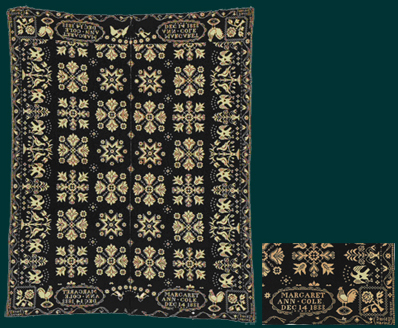 |
Bergen County, New Jersey was settled in the 1600s by people from Holland. The floral motifs on Margaret Ann Cole’s 1833 Bergen County coverlet look very Dutch. ID.2007.72.84 Gift of the Fred and Margaret Brusher Family |
When Margaret Ann Cole ordered this coverlet, she didn’t have to travel very far. The weaver was David D. Haring, a neighbor. Margaret was probably a widow in her 60s when she had this coverlet made for her Bergen County, New Jersey home.
Bergen County was settled by people from Holland in the 1600s. Margaret may have been of Dutch ancestry. Her husband’s family--originally spelled Kool in Holland--certainly was. Weaver David Haring’s ancestors were also from Holland and his coverlets look very “Dutch.” The designs are arranged in neat rows and the motifs include roosters, a popular Dutch folk art symbol.
Why does Margaret’s name appear backwards on one side of the coverlet? Coverlets were often woven in two panels. One was reversed and the two sewn together at a center seam.
Leah Heiges of York County, Pennsylvania
1841
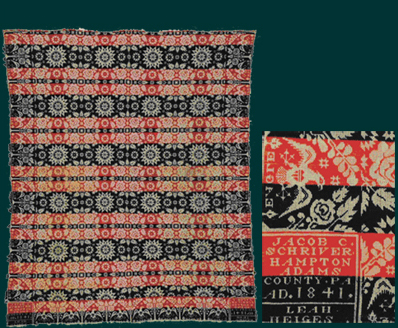 |
Leah Heiges’ 1841 coverlet, made by Jacob Schriver, displays the multiple colors popular in Pennsylvania German communities. ID.2007.72.88 Gift of the Fred and Margaret Brusher Family |
The owner of this coverlet was Leah Heiges, a young farmer’s wife--a common customer for coverlet weavers. Leah and her husband David, a prosperous York County, Pennsylvania farmer, had at least seven children.
The Heiges family home was about 13 miles from that of weaver Jacob Schriver of Adams County, Pennsylvania--a fair distance in the 1840s. Schriver, of German ancestry, learned the weaving trade from his father. The multiple colors shown in this coverlet made for Leah Heiges were popular in Pennsylvania German communities.
Clarissa Garter of Orleans County, New York
1842 and 1847
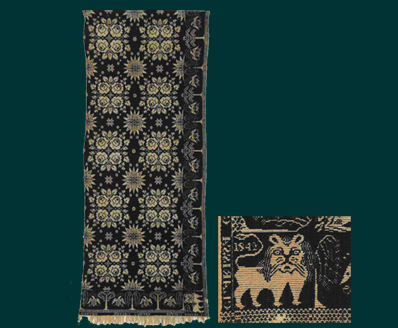 |
This 1842 coverlet, with its “Double Roses” design, was originally two panels joined at a center seam, but only one panel has survived. It features weaver Harry Tyler’s lion motif in the cornerblock. ID.2007.72.51 Gift of the Fred and Margaret Brusher Family |
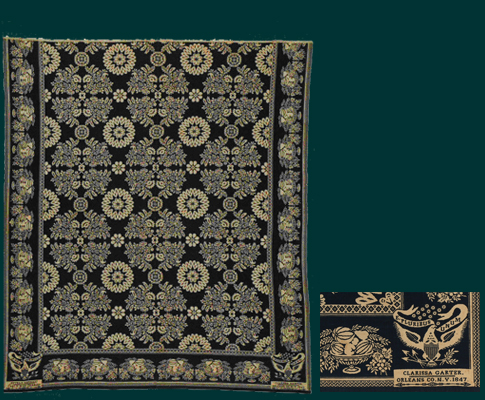 |
Clarissa Garter must have liked her earlier coverlet. She had this similar one made five years later, again probably by Tyler. This 1847 coverlet is also blue and white and features floral designs as well. Here, Tyler includes an eagle in the cornerblock to identify his work. ID.2007.72.44 Gift of the Fred and Margaret Brusher Family |
Clarissa Bentley Garter had these coverlets made for her Orleans County, New York home during the 1840s. A young mother of two small sons, Clarissa likely tucked her children to sleep under these coverlets. Like many mothers during this time, Clarissa lost one of her children. Her older son David died at the age of three in 1844.
Harry Tyler, who wove coverlets and carpets in Jefferson County, New York, probably made Clarissa’s coverlets. Tyler didn’t sign his coverlets, but relied on distinctive designs in the cornerblock to identify his work: first a lion, then an eagle.
When Clarissa and her husband Moses decided to pack up their belongings and move to Michigan in 1854, they brought along these cherished bedcoverings. The Garter family ran a farm and sawmill in Oakland County, Michigan.
| |
-- Jeanine Head Miller, Curator of Domestic Life
|
In 2007, The Henry Ford acquired a collection of 91 antique coverlets from the Fred and Margaret Brusher family. These coverlets are displayed in Henry Ford Museum, seven at a time. Every four months, different coverlets from the Brusher collection are shown.
|
|
|

